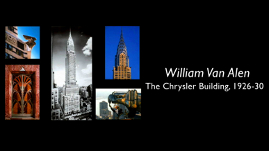Teachers' Domain - Digital Media for the Classroom and Professional Development
User: Preview





Picturing America is a project of the National Endowment for the Humanities, carried out in partnership with the America Library Association, the Institute of Museum and Library Services, and the Office of Head Start.
Funding for the educational resources in this collection was provided by the Institute of Museum and Library Services.
William Van Alen: The Chrysler Building, 1926-30 (Document)
Guide your students in a close reading of the informational text provided with this video. Download William Van Alen: The Chrysler Building, 1926-1930 and make a copy for each student.
Begin by having students read the essay silently. Next, read the essay aloud to the class and have students follow along.
Direct students to refer to the text as they answer the questions below.
A Close Reading of "William Van Alen: The Chrysler Building, 1926-1930"
-----
Visit the NEH Picturing America website to find more innovative ways to integrate works of American art into your teaching.
CAROL WILLIS (FOUNDER AND DIRECTOR, THE SKYSCRAPER MUSEUM): This majestic power, going to the top, ascending to the heights and surveying from this regal vantage. When you say the word skyscraper, it has a very romantic meaning to it.
PAUL GOLDBERGER (ARCHITECTURE CRITIC AND WRITER): The one skyscraper in the world that defines exuberance; there’s something about it that is like an exclamation point on the skyline. The parts are fantastic, and the whole is even more than the sum of the parts. No building meets the sky in quite the way that The Chrysler Building does. There’s something about the beautiful form of the top, those arches and the triangles and the whole composition of it, it never gets tired, it never feels too familiar even though, now, it is one of the most familiar images of a building anywhere in the world.
WILLIS: That scalloped pyramid, in stainless steel of course, the needle-thin tower rising from the center, that kind of helmet-like, or crest, or crown, that was called the vertex at the time, that gives the building its extra height, but the identity of the building really comes from that extra feature as well.
GOLDBERGER: It’s not only a great presence on the skyline; it’s a wonderful presence on the street, a wonderful building to walk past. I look at it, and kind of, you know, you get a smile, your heart has a nice beat to it. It’s the ultimate symbol of the Jazz Age. If architecture could ever express the Jazz Age, The Chrysler Building is the thing that does it better than anything else.
WILLIS: The greatness of The Chrysler Building comes from the quality throughout of the materials, of the design and construction, particularly at the ground level where you see in that great theatrical archway the black granite and the silver streamlining, the entry through the revolving doors into this kind of magical cave of marbles and multi-colored stones, the painting of the progress of technology on the ceiling, the incredible inlaid woods of the elevator doors. All of those aspects speak to the Art Deco style in New York which seems such a kind of fundamental expression of New York’s identity as the modern metropolis in the 1920s.
GOLDBERGER: It came out of that period when being the tallest seemed to mean everything, and there were great battles over whose skyscraper would be the tallest, and The Chrysler Building was kind of locked in a battle with the building at 40 Wall Street, in Lower Manhattan, the Bank of Manhattan Company. Nobody quite knew whose building would be tallest, they kept revising plans and each would kind of inch over the other. Then, because of this wonderful trick that William Van Alen, the architect, had planned, an extra part of the spire was assembled in secret inside the building and lifted up through a hole in the top and attached so that, in fact, it would actually end up taller. It’s a great piece of skyscraper history. Walter Chrysler was famously difficult and Van Alen and Chrysler did not have an easy time of it. For some reason, their relationship didn’t survive the building, and it was also true that it’s the only really major thing that Van Alen did.
Most really serious architecture people, most serious critics, historians, and academics, did not think very much of The Chrysler Building. They found it kind of vulgar. Lovers of old-fashioned buildings thought it was too modern, the lovers of much more ambitiously modern buildings thought it was too fussy and decorative. Then of course, as history played out, The Chrysler Building and William Van Alen had the last laugh because it became everybody’s favorite. All great architecture comes down to something in the end you can’t quite explain. We can talk all we want about proportions and scale and use of material and inventiveness and harmonic balance between different elements, and all that is true, but it can take you 98, 99% toward understanding greatness, but that last percent is something you just can’t put into words.
 Loading Standards
Loading Standards